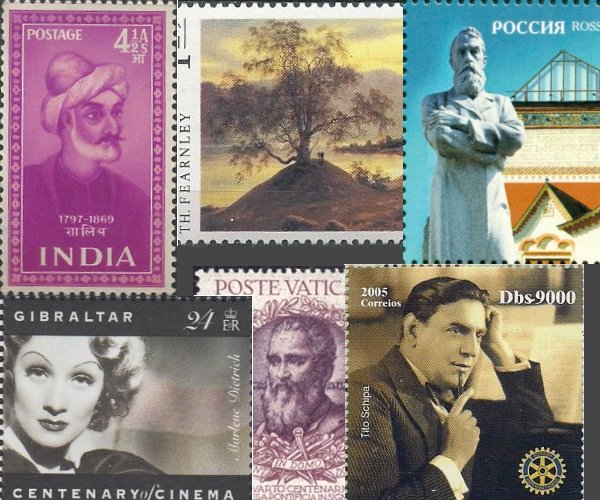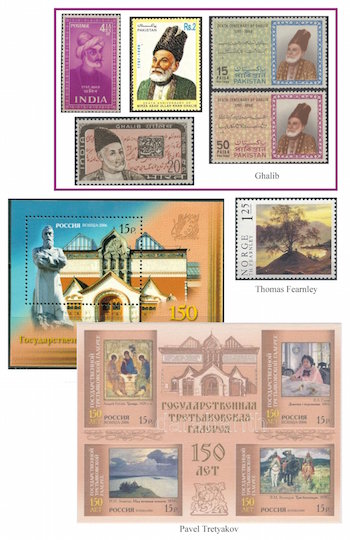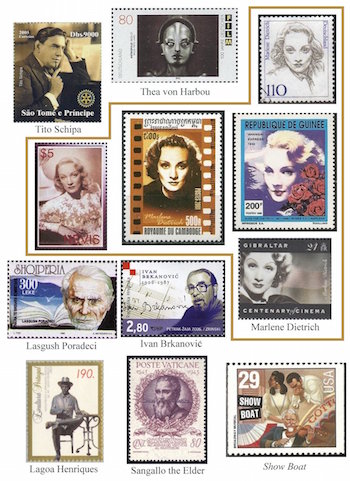The Arts on Stamps of the World — December 27
An Arts Fuse regular feature: the arts on stamps of the world.

By Doug Briscoe
The 19th-century poet known as Ghalib (27 December 1797 – 15 February 1869) was born Mirza Asadullah Baig Khan in Agra, a descendant of Aibak Turks who had left their homeland and moved east on the fall of the Seljuks. Ghalib is seen as a central figure in Urdu poetry, though he also wrote in Persian and considered the works he wrote in that language his finer achievements. Ghalib also left a substantial body of letters that some readers consider to be almost as significant as his poetry. The stamps are from both India and Pakistan.
If the name Thomas Fearnley (1802 -16 January 1842) looks more English than Norwegian, that’s because it is. Fearnley’s grandfather had come from Hull to settle in Norway in 1753. Thomas Fearnley married into a wealthy banking family and founded a dynasty of shipping magnates, but more to our purpose, he was a painter. After studies in Oslo, Copenhagen, and Stockholm, he took time out to paint some pictures for the Swedish royal family, then continued his art education in Germany with Johan Christian Dahl and others. He painted landscapes all over Europe, though the stamp shows one of his Norwegian scenes, Old Birch Tree at the Sognefjord (1839).
Again we make room for a non-artist here on AoSotW. Pavel Tretyakov (December 27, 1832 – December 16, 1898) is the Russian art collector for whom the Tretyakov Gallery in Moscow is named. He began his magnificent collection in 1854 and within just a couple of years envisioned founding a national art museum. A gallery was opened as early as 1867, and in 1892 Tretyakov presented his collection of nearly 2,000 pieces to the city of Moscow. Over the years a number of stamp sets displaying works housed in the gallery have been issued, many of which we’ve shown on the birthdays of the artists. In 2006, the sesquicentennial of Tretyakov’s conception was marked with two souvenir sheets, one showing the facade of the museum (designed by Viktor Vasnetsov and completed in 1904), along with a statue of the founder. The other, in addition to showing the building, offers four art works from the collection, The Holy Trinity by Andrej Rublev (c1420), A Girl with Peaches by Valentin Serov (1887), Above the Eternal Calm by Isaac Levitan (1894), and Vasnetsov’s Three Heroes (1898). Incidentally, the philanthropist’s daughter Vera married the great piano virtuoso Alexander Siloti.
The great Italian tenor Tito Schipa was born Raffaele Attilio Amedeo Schipa on 27 December 1888. After study in Milan, he first appeared on stage in Vercelli in 1910. Early on he sang in Buenos Aires, to which he would return in later years. Schipa was the first Ruggiero in Puccini’s La rondine in 1917. Two years later, he went to the US and joined the Chicago Opera Company, switching to the Met in 1932, where he appeared until 1935 and again in 1941. This American career, which included also a stint at the San Francisco Opera from 1924, did not prevent Schipa from singing at regular intervals in Italy (La Scala, Milan, Rome). I was surprised to learn that he not only recorded tangos but even composed some. From his retirement in 1958, he taught voice, first in Budapest, later in New York, where he died of diabetes on 16 December 1965, aged 77. The only Tito Schipa stamp I’m aware of comes from a block of four from the island nation of St. Thomas celebrating renowned tenors.

We’ve already seen this Metropolis stamp when we saluted Fritz Lang on his birthday at the beginning of this month. We present it again for Lang’s second wife Thea von Harbou (27 December 1888 – 1 July 1954), who wrote the screenplay. Harbou had been a child prodigy, conversant with several languages, a pianist and violinist, and a published writer at 13. Husband and wife (she had also been married before, to the actor Rudolf Klein-Rogge, from 1914 to 1920) collaborated on a number of other projects. Both Lang and Harbou pursued other relationships (Lang rather more so), and the couple divorced just before Lang’s departure from Germany in 1933. Harbou, a follower of National Socialism, stayed behind, directed two films on her own in 1934, and continued writing scripts. Five years after her death, Lang directed a movie, The Indian Tomb (1959), that was based a Harbou novel of 1918.
While we’re in the world of German cinema, let’s turn to another talent born on this date, the inimitable Marlene Dietrich (1901 – 6 May 1992). At age eleven, she conflated her first two birth names, Marie and Magdalene, into Marlene. Like Harbou she was also an able violinist until she suffered a wrist injury. She was on stage from 1922 and in films starting in 1923. In 1930, the year of The Blue Angel, she came to the US, applying for citizenship in 1937 and receiving it two years later. During the war she was a tireless supporter of the troops and of refugees. Her impressive list of lovers (the men, that is) reputedly included Gary Cooper, John Gilbert, Douglas Fairbanks Jr., Errol Flynn, James Stewart, Erich Maria Remarque, Jean Gabin, John Wayne, John F. Kennedy, and Frank Sinatra. Dietrich appears on a number of stamps from all over the world. Here are a few of them (one from Cambodia!).
We back up two years from Marlene Dietrich’s 1901 birth to that of Albanian poet and writer Llazar Sotir Gusho (27 December 1899 – 12 November 1987), who used the pen name Lasgush Poradeci. His education took him from his native Pogradec to Monastir to Athens to Bucharest; then he earned his doctorate in Graz. He published poems in periodicals, but saw only two volumes (1933 and 1937) through print. Poradeci also translated Heine, Goethe, Brecht, and Pushkin into Albanian. Ostracized by the Communist government, he died in poverty.
We remain in the Balkans for Ivan Brkanović (27 December 1906 – 20 February 1987 ), father of the composer and conductor Željko Brkanović. He studied in Zagreb and Paris and later became a professor at the Sarajevo Music Academy and director of the Zagreb Philharmonic, as well as a playwright. He was also active as a music publisher and was president of the Association of Croatian composers. His works include two operas, a ballet, Helots (1960), five symphonies, a Sarajevo Suite for orchestra (1957), three string quartets, and a number of choral pieces, including a Mass profana Croatica, which, after his death in 1994, was completed by his son.
The Portuguese sculptor and art teacher Lagoa Henriques (27 December 1923 — 21 February 2009) is best known for his sitting statue of the poet Fernando Pessoa, which resides outside the Café A Brasileira in Lisbon and can be seen on the stamp. Henriques had also carved Pessoa’s new gravestone in 1985; the statue followed three years later.

The Italian Renaissance architect Antonio da Sangallo the Elder, born about 1453, died on this day in 1534. Born at Florence to a woodworker, Sangallo worked with his brother Giuliano on many projects but also created a number on his own, notably the church of San Biagio at Montepulciano. He excelled at the design of fortifications. He was able to enjoy an early retirement and devote himself to farming. Incidentally, he was godfather to the orphaned Giulio de Medici. The family took the child into their home unsuspecting that he would one day become Pope Clement VII. Sangallo the Younger, by the way, another architect, was our man’s nephew, not his son.
Show Boat, “considered”, says Wikipedia, “to be the first true American musical play”, opened at the Ziegfeld Theatre on Broadway on this date in 1927. It was based on a novel by Edna Ferber and was one of a select group of popular American musicals celebrated on a stamp set from 1993.
The actors Sydney Greenstreet (1879 – 18 January 1954) and Gérard Depardieu (born 1948) were both born on December 27th.
A graduate of the University of Massachusetts with a B.A. in English, Doug Briscoe worked in Boston classical music radio, at WCRB, WGBH, and WBUR, for about 25 years, beginning in 1977. He has the curious distinction of having succeeded Robert J. Lurtsema twice, first as host of WGBH’s weekday morning classical music program in 1993, then as host of the weekend program when Robert J.’s health failed in 2000. Doug also wrote liner notes for several of the late Gunther Schuller’s GM Recordings releases as well as program notes for the Boston Classical Orchestra. For the past few years he’s been posting a Facebook “blog” of classical music on stamps of the world, which has now been expanded to encompass all the arts for The Arts Fuse.
